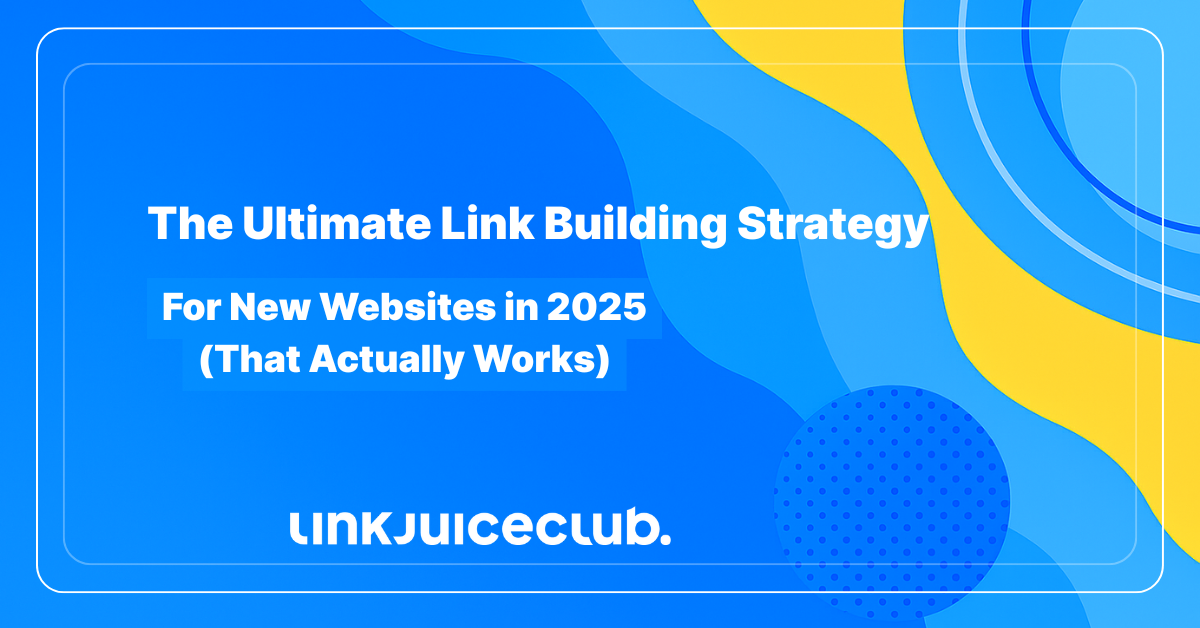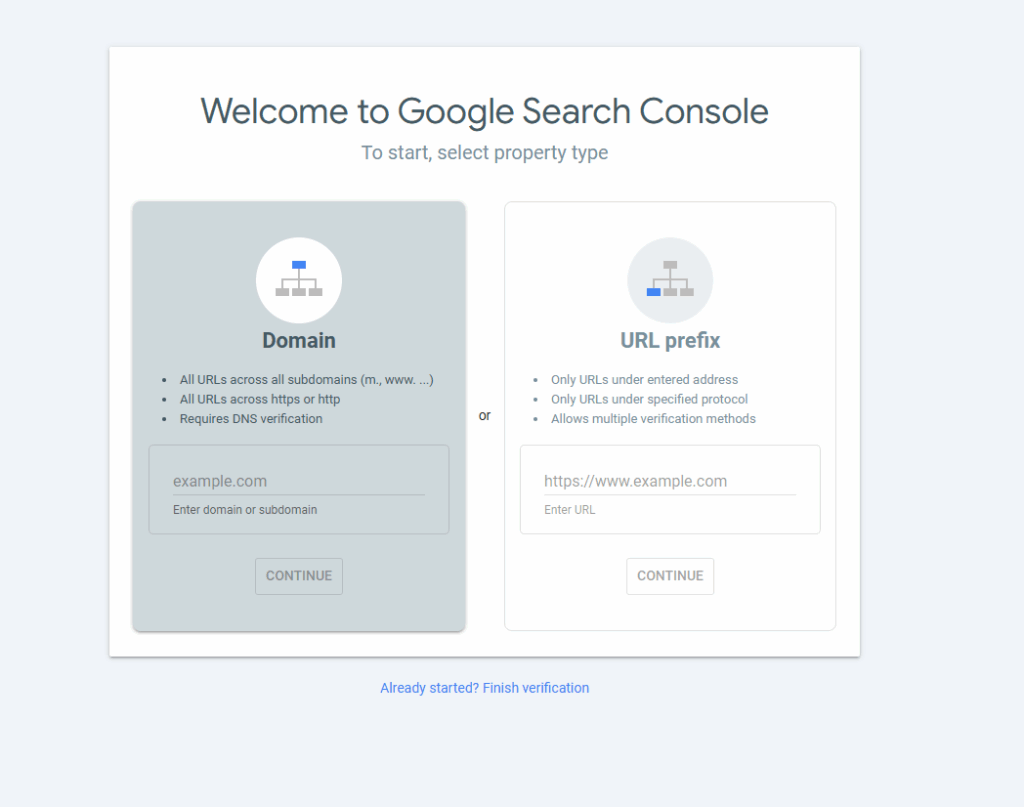
The Ultimate Link Building Strategy for New Websites in 2025 (That Actually Works)
Are you launching a brand-new website and waiting for backlinks to magically appear? You might as well stare at a dumbbell and expect biceps to grow. Hope is not a strategy!
The reality? Google wants real brands, squeaky-clean signals, and trust built from every possible direction. And if your site doesn’t check those boxes, you’re going to feel like you’re screaming into the void.
But here’s the thing: new sites can still win.
You don’t need to be a VC-backed SaaS, a 10-year-old blog, or a household name. You just need to be strategic, persistent, and a little bit fearless with how you deploy your time, budget, and outreach.
This isn’t a theory. This is the same link building strategy for new websites we use to get real results, fast. We even apply those same strategies in brutal, oversaturated niches.

What You Need to Know Before You Start
Save this. Live by it. Because this is the framework that turns new domains into ranking machines:
- Link building is a process, not a plug-in-and-go tactic.
- Start with foundations. Build trust. Then scale.
- Safe + aggressive strategies = the winning formula (if you know how to use them).
- Watch your data. Scale what’s working, and kill what’s not.
If you have successfully acquired this knowledge, we should get into the good stuff, like right now!
Why New Websites Struggle With Link Building (And What You Can Do About It)
Let’s not sugarcoat it: link building as a brand-new site is a grind. You’re walking into Google’s world with no reputation, no backlinks, and no leverage. All you have is a shiny domain and a dream. But everything starts with that, right?
Here’s why the climb feels like a vertical wall:
You Haven’t Built a Reputation (Yet)
No traffic. No audience. No clout. When you’re just starting out, nobody’s itching to link to your homepage or mention your brand. Why would they? You’re the digital equivalent of a brand-new coffee shop on a quiet street; open for business, but no one’s walking through the door just yet.
Google Doesn’t Trust You
Google doesn’t believe in love at first crawl. New sites are under a digital microscope. You need to earn trust through consistency, credibility, and structure. Until you send the right signals, expect the algorithm to keep you at arm’s length.
Everyone’s Buying Links… Badly
Link buying is no longer some underground tactic, it’s the default. But here’s the catch: most people are buying junk. Low-quality placements, expired domains, irrelevant anchors, you name it. That makes actual high-authority links rarer, pricier, and harder to land. If you want links that move rankings, you’ll have to step above the noise.
The “Sandbox” is Real
Call it what you want: sandbox, probation, digital purgatory. New sites get throttled. They might rank a little, then drop. Or they’ll hover on page five for months until something clicks. This isn’t speculation; it’s been backed by real data, and more recently, exposed in algorithm leaks. Google plays gatekeeper, and you need to earn your spot.
So How Do You Actually Build Links as a New Site?
Here’s the good news: every dominant site in your niche started from scratch too. No links. No trust. No advantage.
The only difference? They had a real link strategy. And they executed it.
To break through the wall and fast-track your rankings, you need four key components working together like a machine:
1. Start With Authority Foundations
You need to exist in Google’s eyes before you can compete. That means stacking entity signals, building citations, creating social profiles, and pushing branded mentions. It’s not glamorous, but it’s non-negotiable.
2. Scale Intelligently
Most sites stall out because they get to DR10 or DR15 and plateau. Why? They never built a process to grow consistently. If you want to win, you need a system that scales, one that feeds itself, not burns you out.
3. Build Real Links (Not Fiverr Trash)
This isn’t 2013. Low-quality, $5 guest posts aren’t just ineffective, they can tank your site. Focus on getting real links from real sites in your vertical.
4. Blend Safe & Aggressive Like a Pro
White hat only? You’ll move like a sailboat in the dead wind. All gas, no brakes? Risky. The smart operators mix both. Play clean with brand mentions and citations. Then use strategic, controlled aggression to hit competitive pages where it counts.
Build First, Rank Later: The Power of Foundation Links & Entity Stacking
Before you chase high-authority placements or start scaling outreach, your site needs a baseline of credibility. And no, that doesn’t mean pumping out blog posts and hoping for the best. It means building trust signals that show Google your brand is legit, even if you’re just getting started.
This early-stage work isn’t sexy, but it’s absolutely essential. If you skip it or half-bake it, everything else you do will be built on a shaky foundation. So let’s break it down.
What Foundation Links Actually Do for You
Foundation links are your site’s digital footprint. They come from social profiles, citations, directories, and reference pages that give Google a basic sense of who you are.
These links won’t rank you for competitive keywords, and they’re not supposed to. Their job is to establish your brand’s existence, balance your anchor text profile with branded and naked links, and reduce the risk of getting hit when you start building stronger, more aggressive backlinks.
Entity Stacking: Making Google See You Everywhere
Entity stacking takes that foundation one step further. It’s the process of creating a consistent, unified brand presence across every platform Google touches. This means locking in your name, address, phone number, logo, and company description.
This also includes repeating that information, word-for-word, across sites like About.me, LinkedIn, Medium, Facebook, and beyond.
This uniformity is what connects the dots. The more places Google finds that reinforce the same details about your brand, the more confident it becomes in associating those signals with your domain. That confidence turns into trust, and that trust turns into rankings!
Consistency Is Your Competitive Edge
Most beginners stop after claiming ten or so social accounts and call it good. That’s not enough!
Your goal is to create a recognizable, consistent brand footprint across the web, something that looks like a real business, not a side hustle built on a template.
Start by finalizing your branding: company name, logo, boilerplate bio, and NAP. Then apply it everywhere, from your social media bios to your business directories and even embedded in your website’s schema.
Earning Your First Authority Links the Smart Way
Foundational links will help you get noticed by Google; they’ll get your site crawled, indexed, and maybe even ranking for some low-hanging keywords.
But if you want to compete in real niches with real competition, you’re going to need more than trust. You need firepower, links with actual authority behind them.
This is how the pros do it, and how you can too with our help!
1. Leverage What You Already Have
Most site owners don’t realize they’re already sitting on a few high-quality link opportunities. If you’ve launched your site and haven’t made any noise about it yet, now’s the time.
Post about it on your personal and professional socials. Announce it like it matters (because it does!).
You’d be surprised how often friends, colleagues, clients, or even friendly competitors are willing to drop a link, mention your brand, or feature your launch.
If you’ve worked on other websites, now’s also the time to use them. Do a crossover piece, publish a short interview, or reference your new project on an existing blog you control. It’s basic, but massively underused.
2. Press & PR: The Scalable Way to Build Authority
If you want to earn trust at scale, press coverage and digital PR are your best friends. Even new brands can land media attention with the right angle.
A launch announcement is a great place to start. Frame your site as a fresh solution in your industry and pitch it to startup blogs, local news outlets, or niche-specific publications.
Got a unique opinion or fresh data? Package it up. Run a small survey, pull together insights, or comment on a trend that’s blowing up in your space. Journalists are always looking for timely, expert input, and if you can deliver that, links often follow.
3. Outreach That Doesn’t Get Ignored
Let’s get something straight: no one’s handing you a backlink out of kindness.
And if your outreach sounds like it was copied from a forum thread in 2009 (“Dear sir, I admire your website…”), it’s heading straight to the spam folder without a second glance.
Instead, focus on value-first outreach. Well-written guest posts still work if you’re targeting sites that have actual audiences and editorial standards.
Don’t waste time on spammy write for us directories; they’ve been rinsed to death. Look for niche-relevant blogs, active communities, and platforms that post real content.
Another underrated angle? Position yourself as a source. Whether it’s via Qwoted, HARO, or directly reaching out to journalists and podcast hosts, offering a useful quote, insight, or stat can earn you solid backlinks.
And don’t underestimate the power of ego-bait. Highlight or feature key players in your space. People love being recognized, and many will return the favor with a link or share.
4. Don’t Start With Spam (Seriously)
It’s tempting to go all-in out of the gate: buying cheap guest posts, hitting up random PBN sellers, or throwing together sketchy link wheels because everyone else is doing it. Don’t. In 2025, Google’s crawler is smarter, faster, and more suspicious than ever, especially with fresh domains. Aggressive moves without a foundation just make you look like a short-term spammer, not a long-term player.
And please, stop waiting around for natural links to show up. That ship sailed over a decade ago.
Unless you’re a well-known brand or have an in-house PR team, almost no one is linking to your blog post for free. Yes, there are exceptions, but basing your strategy on hope is not how you climb the SERPs.
5. Measure What Matters – and Build Momentum
Once you’ve landed your first few solid links, your next job is to use that momentum wisely.
Every quality backlink should help you unlock more opportunities.
Track your results ruthlessly. Use tools like Ahrefs, SEMrush, and Google Search Console to monitor which links are indexing, which pages are gaining traction, and how your anchor text profile is evolving.

If a certain outreach angle keeps getting ignored, drop it. If a particular type of link moves the needle consistently, scale it. The faster you learn what works, the faster you grow!
How to Blend Safe and Aggressive Link Building Without Getting Burned
If you’re only doing what Google says is best practice, be prepared to wait… a long time. But if you go all-in on what Google hates? Sure, you might get fast results, but you’re also playing roulette with your rankings.
So what’s the move?
The SEOs who win don’t live on either extreme. They mix safe and aggressive tactics with intention, not impulse. The difference is strategy.
This isn’t about being reckless or overly cautious; it’s about understanding your site’s stage, goals, and limits.
Here’s what you should be thinking about:
💣 What are your competitors doing, and how do you beat them?
Open up Ahrefs or SEMrush and reverse-engineer your competitors’ link profiles. See what’s working, what they’re missing, and how aggressive they’re being. Use that insight to guide your own strategy!
💣 How many pages are you actively building links to?
If it’s just one or two, building 100 backlinks in a month is going to look shady fast. But if you’re distributing those links across dozens, or even hundreds, of pages, that same number becomes far more natural.
💣 What’s your current link velocity, and does it match your site’s profile?
There’s no universal safe speed. A 3-month-old blog adding 50 links overnight raises red flags. A robust authority site doing the same? Not so much. Context matters more than raw numbers.
💣 How does your budget impact your choices?
If you’re working with limited cash, don’t try to match big brands link for link. Focus on quality and ROI. One strong contextual link can do more than five generic ones if it hits the right page with the right anchor.
Scaling Link Building: From Hustle to High-Performance System
Link building shouldn’t feel like a fire drill. If you’re scrambling to build links only after rankings drop or traffic slows, you’re playing from behind.
Winning in 2025 means building a repeatable system, a process that works whether you’re at DR10 or DR70.
1. Systematize the Work That Doesn’t Need You
You shouldn’t be manually submitting citations or writing every guest post yourself. That’s not hustle; that’s poor resource management (just being honest).
Start by documenting every recurring task in your process. Build SOPs (or borrow them) and create templates that sound human, not robotic.
Once you’ve got structure, bring in support. Use outreach tools like Pitchbox or even Gmail mail merge to automate initial contact and follow-ups.
Hire VAs or junior SEOs to handle groundwork, things like scraping contact info, qualifying prospects, and submitting forms. They can do it faster and cheaper, freeing you up to focus on strategy, not busywork.
2. Outsource With Oversight
Outsourcing is smart. Abdicating responsibility is not. Many SEOs make the mistake of assuming they can buy their way to the top, so they hand off link building to vendors and never check the work.
That’s how you end up paying for backlinks on dead sites with ghost traffic and bloated numbers.
No matter who’s building your links, you should always vet them yourself. Check the domain history. Look at traffic patterns. Confirm topical relevance.
And remember: nothing scales better than real relationships. Build connections with journalists, bloggers, and webmasters. People remember you. Vendors don’t.
3. Batch Like a Pro
Drip-feeding a handful of emails each day is a slow grind. If you want momentum, start thinking in batches.
Prospecting should happen in concentrated sprints, scrape dozens (or hundreds) of link opportunities at once, qualify them, and build your lists ahead of time.
When it’s time to reach out, do it in waves. Send 50 to 100 personalized, well-targeted emails over a few days. You’ll get more responses, more momentum, and more feedback to refine your message.

Key Takeaways: The Mindset and Method That Drive Real SEO Wins
Let’s keep it real: there are no shortcuts. No secret sauce guest post bundles. No one-size-fits-all hacks. The only thing that works nowadays is showing up consistently with a smart, relentless strategy.
Most new sites fail because they floated around with zero plan, outsourced blindly, or froze every time the algorithm sneezed. This game doesn’t reward hesitation. It rewards execution.
If you want to rise in the SERPs, treat your site like a real brand. Build the foundation. Stack trust. You’re going to make mistakes. You’ll probably burn cash. Some emails won’t get answered. Some links won’t move the needle. That’s all part of the deal.
But here’s the thing: the people who win are the ones who don’t flinch. They keep iterating, they learn fast, and they never get emotionally attached to one tactic. That’s how you outpace competitors who are still crying into their Slack threads about Google’s unfairness.
So if you’re still waiting for a perfect time to start building links, stop. The only winning link building strategy for new websites is the one that’s executed consistently even when it’s messy.
Close the tabs, stop overthinking it, and get moving. Because while everyone else is stuck watching YouTube tutorials, you’ll be the one pulling ahead with real rankings and results.
Game on.





